Huitong.com, January 3rd - Tuesday's (January 3) spot gold rebound was blocked. It rose to around $1,158 earlier, but as the dollar regained its gains, the price of gold fell again to around $1,150. The market is still paying attention to the minutes of the Federal Reserve's monetary policy meeting released this week and the non-agricultural employment report for December; the crude oil market, due to the official implementation of production cuts by oil-producing countries, boosted the market's confidence in the oil market to restore supply and demand balance, oil prices soared more than 2 % hit a new year and a half.
Serving the industry with our best quality
products, we manufacture, supply Coral Fleece slipper. This product has perfect
fittings and made with excellent quality. It ensures durable finish and water
resistant. It does not give uncomfortable feel at first wear. These are offered
in various sizes, depending upon the need of the client. We have been applauded
for this superior quality product every time we have delivered.
White Hotel Slippers,Plush Hotel Slipper,Close Toe Coral Fleece Slipper,Hotel Plush Slipper Yangzhou Lansun Slipper Co.,Ltd , https://www.lansunslippers.com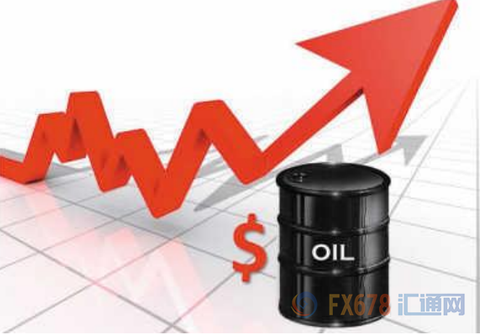
[The dollar is approaching a four-year high, and the rebound in gold prices is at risk of distress]
The US dollar index regained its gains on Tuesday, not only regaining all the earlier declines, but also regaining the 103-integer mark, hitting a maximum of 103.52, and approaching the nearly 14-year high again, causing the gold price to rebound again. The current price of gold has fallen back to around $1,150. Relatively optimistic about the Fed’s interest rate hike in 2017, it is still providing support to the US dollar, while the gold ETF holding position is reduced to an eight-month low, and the downside risk of gold prices has increased. 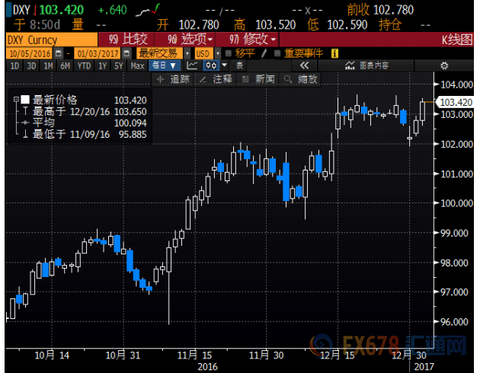
(Dollar Chart Daily Chart)
Jiang Shu, chief analyst of Shandong Gold, said that the market is waiting for the US non-farm payrolls data released on Friday (January 6). If the data is lower than expected, the gold price has a strong rebound. In the long run, it is expected that the US interest rate hike will suppress the price of gold this year. If there is any uptrend in gold in the first quarter of 2017, it will be a medium-term technical rebound, rather than a long-term trending uptrend driven by fundamentals.
Huitong.com reminded investors that the non-farm payrolls report for the US in December should be focused on. The analysts pointed out that the non-agricultural employment performance in December of the past ten years has not performed as well as in November, and investors still need Observe changes in hourly payroll data.
Brown Brothers Harriman (BBH) said that the market expects non-farm payrolls to be about the same as the increase of 178,000 in November, but we think the actual performance may be disappointing. In the past ten years, the growth rate of non-farm payrolls in December has been less than November, and all of the past three years are all less than November. In addition, the US economic growth has shown signs of slowing since the third quarter of last year.
The agency also pointed out that the most important concern in this Friday's non-agricultural report is the hourly salary data. The data fell 0.1% in November, which made the market very disappointed. The annual rate increase is expected to rise to 2.8% in October, 2.6% in December 2015, 1.7% in December 2014, and 2.0% in December 2013.
In addition, Beijing time on Thursday morning will also release the minutes of the Fed's December monetary policy meeting, investors need to pay attention.
Huitong.com reminded that in December 2016, the Federal Reserve raised interest rates by 25 basis points and issued a hawkish rate hike plan. It is expected to raise interest rates three times next year, which is higher than the expected two times at the end of September. The minutes are expected to convey more details about the number of interest rate hikes in 2017 and the next rate hike.
There are three major points in the minutes of this meeting: 1. The time when the Fed may raise interest rates next time. 2. Whether the truly influential voting committee also supports “three interest rate hikes next yearâ€. 3. Whether to comment on the future of Trump policy.
Ryan Larson, head of stock trading at Royal Bank of Canada Global Asset Management, said that next June may be the most likely to raise interest rates, because Trump will implement specific measures and the economic impact of these policies after taking office in January next year. It is still unclear, the Fed still needs to observe for a while. 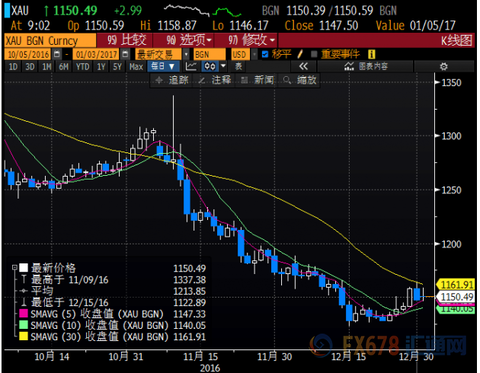
(Spot gold daily chart)
For gold, Huitong.com reminded that since November 11, the world's largest gold ETF holdings have been in a state of decline, and has now dropped to 822.17 tons, an eight-month low, which is not conducive to the gold midline trend.
Huitong.com believes that the overall rebound of gold prices is still relatively weak. The Bollinger Middle Line has formed a strong resistance to the price of gold. The downside risk of gold prices has increased again. The following is concerned with the support around the 5-day moving average of $1,147, focusing on the 10-day moving average. Support near $1,140, ​​once the position falls, gold prices are expected to return to the downtrend; but if the gold price can stay above that position, then the market outlook still has the opportunity to explore the resistance near the 23.8% retracement of the previous decline of $1,172. 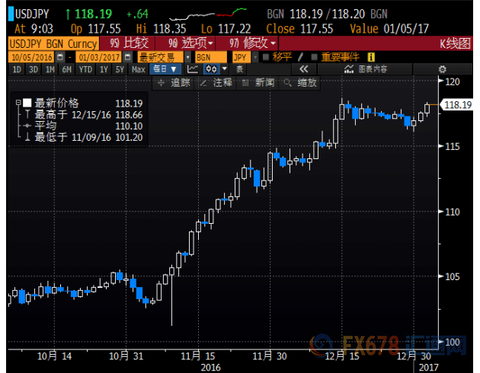
(USD/JPY daily chart)
In the foreign exchange market, due to the strengthening of the US dollar, non-US currencies were generally under pressure. The euro fell below the 1.04 mark against the US dollar, setting a four-day low to 1.0375. The pound hit a low of 1.2248 against the US dollar, hitting a three-day low. The US dollar against the yen was slightly higher. , refreshed the two-week high to 118.35.
For the yen, FXStreet chief analyst Valeria Bednarik pointed out that from a technical point of view, the USD/JPY daily gains were suppressed by the downtrend line from the December high of 118.66, but maintained a bullish trend, as in the 4-hour chart, The exchange rate rebounded from the 100-ken moving average. In addition, on the same chart, the momentum indicator rose above the 100 level, and the RSI indicator consolidated around 56, reflecting a lack of trading volume, rather than a lack of buying interest. The recovery momentum needs to continue above 117.90 to retest the highs for several months and further increase to the 120.00 area. On the other hand, a break below 116.00/20 may attract buying interest.
[Oil market confidence is bursting, oil prices soared more than 2% to create a year and a half high]
International oil prices fluctuated and rose on Tuesday. The US crude oil main contract rose more than 2%, hitting a year-and-a-half new high to 55.24 US dollars / barrel, Brent crude oil also hit a year and a half high to 58.37 US dollars / barrel, because the oil-producing countries have begun to formally The implementation of production cuts will help alleviate the current oversupply problem, boost investors' confidence in the oil market to restore supply and demand balance, and help oil prices rise. Technically, if US oil can stand above the previous high of US$54.5. The market outlook is expected to rise further to $60. 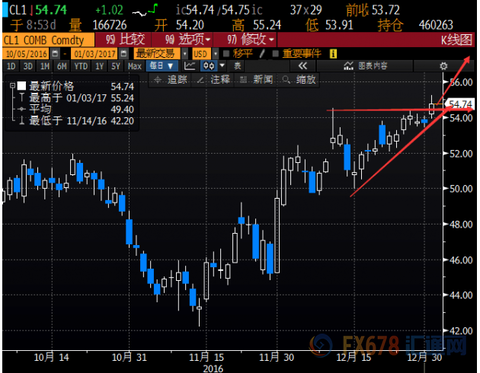
(US crude oil main contract daily chart) 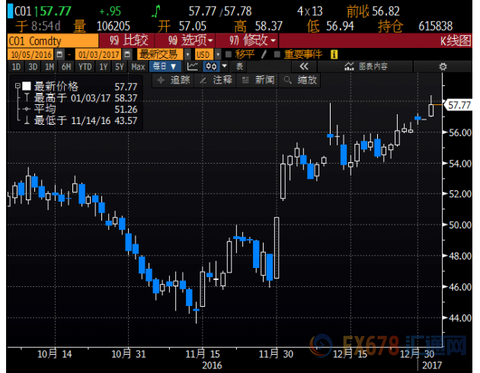
(Brent crude oil main contract daily chart)
According to Huitong.com, Kuwait Oil Company (KOC) CEO Jamal Jaafar said on Saturday (December 31) that Kuwait will close 80-90 oil wells from January 2017 in accordance with the previously agreed crude oil production reduction agreement. Production was reduced by 130,000 barrels per day to 2.75 million barrels per day.
In addition, OPEC member Oman has informed customers last week that it will cut the number of oil contract allocations by 5% in March.
The Wall Street Journal commented that the OPEC production reduction agreement came into effect on January 1st. The resoluteness of Kuwait and the official statement of Saudi Arabia emphasized that the oil-producing countries cooperated to reduce production, which significantly improved the confidence of energy investors in reducing production.
Ric Spooner, chief market analyst at CMC Markets in Sydney, said the market will look for evidence of a cut in production, most likely that OPEC and non-OPEC oil producers will abide by the agreement, especially at an early stage.
In an interview with CNBC, Alex Dryden, global market strategist at JP Morgan, said January was "the first major test." It is not expected that each oil producing country will be able to fulfill the agreement 100%, but it is expected that the production reduction index will eventually be completed 80%.
However, it should be reminded that the market is still deeply worried about the shale oil in the United States.
According to data released by Baker Hughes, the US oil service company, on the morning of December 31, the number of active oil drills in the US increased by 2 to 525 during the week ended December 30, 2016, for the ninth consecutive week. It has achieved a new high since December 2015. It has recorded an increase of 28 weeks in the past 31 weeks, with a cumulative increase of 209.
Standard & Poor's analyst Thomas Watters pointed out in a report last week that OPEC's production cuts will help improve the current oversupply situation, increase the sustainability of the oil price rebound, and may push oil prices to a new high. However, if oil prices continue to rise, the US shale oil production is likely to rebound quickly, thus starting to limit the upward price of oil prices above $60/barrel.
Jal Irani, senior vice president of Edelweiss Financial Capital Markets, also said that any further increase in oil prices could be offset by an increase in US shale oil production, which would eventually lead to a balanced price. Brent crude oil is expected to hold steady around $55 a barrel in 2017.
Huitong.com believes that US oil has now broken the important resistance around US$54.5. The daily level has risen above the rising triangle. If the bulls can hold the position in the day, the market is expected to rise further to the vicinity of the US$60 mark. However, investors should also pay attention to the fact that some technical indicators have a divergence signal. If the oil price falls back below US$54.5, the risk of short-term oil prices will increase again.